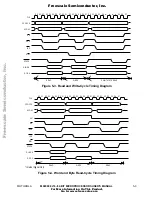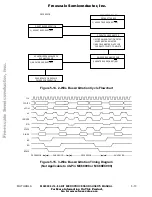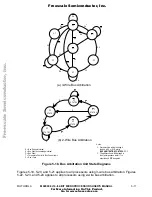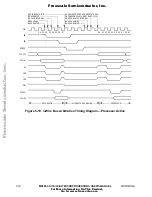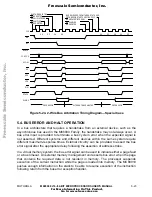
MOTOROLA
M68000 8-/16-/32-BIT MICROPROCESSORS USER'S MANUAL
5- 15
bus request signal. When no acknowledge is received before the bus request signal is
negated, the processor continues the use of the bus.
5.2.2 Receiving The Bus Grant
The processor asserts
BG
as soon as possible. Normally, this process immediately follows
internal synchronization, except when the processor has made an internal decision to
execute the next bus cycle but has not yet asserted
AS
for that cycle. In this case,
BG
is
delayed until
AS
is asserted to indicate to external devices that a bus cycle is in progress.
BG
can be routed through a daisy-chained network or through a specific priority-encoded
network. Any method of external arbitration that observes the protocol can be used.
5.2.3 Acknowledgment Of Mastership (3-Wire Bus Arbitration Only)
Upon receiving
BG
, the requesting device waits until
AS
,
DTACK
, and
BGACK
are negated
before asserting
BGACK
. The negation of
AS
indicates that the previous bus master has
completed its cycle. (No device is allowed to assume bus mastership while
AS
is
asserted.) The negation of
BGACK
indicates that the previous master has released the
bus. The negation of
DTACK
indicates that the previous slave has terminated the
connection to the previous master. (In some applications,
DTACK
might not be included in
this function; general-purpose devices would be connected using
AS
only.) When
BGACK
is asserted, the asserting device is bus master until it negates
BGACK
.
BGACK
should not
be negated until after the bus cycle(s) is complete. A device relinquishes control of the bus
by negating
BGACK
.
The bus request from the granted device should be negated after
BGACK
is asserted. If
another bus request is pending,
BG
is reasserted within a few clocks, as described in 5.3
Bus Arbitration Control. The processor does not perform any external bus cycles before
reasserting
BG
.
5.3 BUS ARBITRATION CONTROL
All asynchronous bus arbitration signals to the processor are synchronized before being
used internally. As shown in Figure 5-17, synchronization requires a maximum of one
cycle of the system clock, assuming that the asynchronous input setup time (#47, defined
in Section 10 Electrical Characteristic) has been met. The input asynchronous signal is
sampled on the falling edge of the clock and is valid internally after the next falling edge.
F
re
e
sc
a
le
S
e
m
ic
o
n
d
u
c
to
r,
I
Freescale Semiconductor, Inc.
For More Information On This Product,
Go to: www.freescale.com
n
c
.
..



